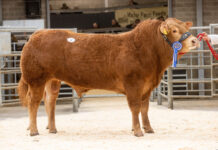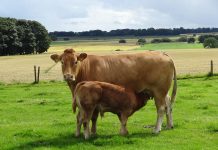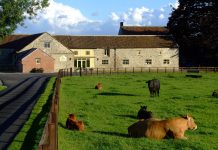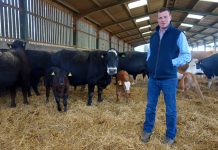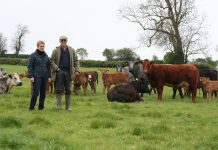Sustainability may be the buzzword of the last decade, but it’s something Chris Passmore has always strived to achieve in his mixed farming system.

Mr Passmore, who farms 344ha (850 acres) on the South Downs at Lancing, maintains that his integrated farming system is simply doing what’s best for the land he manages, the crops he grows and the stock he rears.
But, with a keen eye for the environment too, the farming system at Applesham Farm, Coombes, has been tailored to make the most of the land while also putting something back into it.
“We’re a downland farm and have to respect the soils we work with, most of our ground is shallow soils overlying chalk and it’s a dry farm, so we can’t just go stripping everything out of it and not putting anything back,” explains Mr Passmore who farms with his nephew Hugh.
Stocking on the farm includes a 70-cow Limousin-based suckler herd and a 350-ewe Lleyn and Texel cross flock, with both the livestock enterprises used to maximise soil fertility and organic matter to aid the arable crops grown.
“Two thirds of the farm is in a seven year rotation, with the remaining third, alluvial brookland by the river Adur, in a permanent arable rotation. The rotation on the main block comprises a three year grass and clover ley followed by two wheat crops and two years of spring barley. The second spring barley crop is then undersown with a grass clover ley again.”
And to help build organic matter in the soils a break crop of stubble turnips is grown between the second wheat and the first spring barley crop and a crop of mustard is sown between the two spring barleys.
“By doing this, we’re building fertility and reducing our reliance on artificial fertilisers, but we’re also putting organic matter back into the soils and providing winter feed for the sheep flock. This gives the grass a break over winter and helps reduce the worm burden on the grassland.”
Not that all the grass is rested, however, as the suckler herd spends the winter grazing leys adjacent to unimproved grassland banks which are eaten down through the autumn and winter too. “These banks, about 70 acres in total are un-croppable, unimproved chalk grassland which are part of a higher level stewardship agreement and are largely bordered by blocks of arable reversion ground which are quickly coming into their own too.
“Where these areas border arable fields they are grazed in early autumn once the arable crops have been combined when the cows are let on to clear up the stubbles.
“These rough grass areas are ideal for cow grazing later in the year and this suits their management too as it means we can eat them down tight and then let them regenerate through the summer and the wild flowers have a chance to bloom too.”
While Mr Passmore believes in working with the natural environment he is also adamant that what the public and politicians have to understand is that the South Downs people know and love looks the way it does because it is farmed. “We’ve proved this by leaving a patch of chalk bank to regenerate naturally without grazing. Within 10 years it was thick scrub and over time it’s reverted to scrubby woodland. Nothing like most of the South Downs is today.”
When it comes to breeding the aim is to keep both the cattle and sheep enterprises self contained apart from the purchase of new sires. “I try to breed stock to suit the farm and have found that breeding our own replacements suits the system far better,” adds Mr Passmore.
“Our ground isn’t suited to big heavy cows, so we aim to breed a relatively compact, fleshy cow capable of milking well through our dryer summers and then rebuilding condition through autumn and winter before calving again the following spring.
“What we want to see is a cow with a decent bag of milk on her all summer to do the calf well. While we used to buy in Hereford cross Friesians and Sussex cross Friesians we’ve found that our type of pure Limousin cow is best suited to the system.”
Mr Passmore says the cows are designed to be forage converters, with very little concentrate fed to them apart from around calving. “They receive barley straw ad-lib through the winter, but no hard feed until about four weeks before calving and for a further month after calving.
“Then they receive a home-mixed ration of barley and lupins, with both crops grown on the farm. We grow lupins one year in two, with enough grown for two years feeding requirements, so no feed, apart from minerals is bought in.
“Through the winter we feed barley straw with a bale unroller and simply lay it across the field and let the cows pick at it. This avoids excessive poaching damage to the fields and ensures the manure is spread across the field too, rather than being concentrated around a ring feeder.”
Heifers calve at three years old with Mr Passmore preferring this to two year old calving as it gives heifers a chance to grow on first. “Our heifers are run on a block of ESA grassland to grow on and this suits both the heifers and the farm. It means they have good levels of forage to eat, but doesn’t allow them to grow too quickly.”
And with the cows remaining out all winter they also calve outside too, meaning sire selection is paramount, with the preference being for an easy calved bull with the potential for growth. “I look closely at the breeding values and always look for a quiet bull with easy calving attributes.
“I learnt a lot about recording when I first went to France to source Limousins in 1973 and believe the right records are essential. For instance when I was in France buying heifers I looked to buy those which had relatives retained in the herd or sold to other breeders. Any whose mothers hadn’t bred anything kept for breeding didn’t interest me. I wanted proven bloodlines.”
Mr Passmore’s long association with Limousin cattle started when he and his brothers bought a bull from Cambridge AI centre in 1972. “I’d seen a Limousin bull on a stand at the Royal Show that year and was impressed with him, so thought we’d give them a chance if the opportunity arose,” he explains.
“When we bought the bull we put him with six Hereford cross Friesian heifers and were so impressed with the calves that we immediately decided this was the breed for us. When we started selling the progeny deadweight through Brighton Abattoir the manager there was able to pick the carcasses out from the Hereford and Sussex crosses we were sending with them and wanted more of the same.”
Nowadays half the herd is bred pure, with the remainder put to a Sussex bull. “These Sussex calves thrive off the milky Limousin dams and are ideal for the local butcher’s trade which is what we target them at. They produce handy weight carcasses and have excellent meat quality.”
Calves from the herd are housed for their first winter, with steers sold privately from the farm as suckled calves and whatever heifers aren’t needed for replacements sold too. “The Sussex cross heifers are retained for on-farm finishing and sale to a local abattoir.”
It was another similar chance encounter which led Mr Passmore to the Lleyn breed as the base for the sheep flock and he was once again quick to see the potential of the breed. “I’d heard about them from a contact we had from breeding Texels, so I headed off to a sale in North Wales to see what I could get.”
He initially bought from four or five different breeders, just getting what he could at the time. Then he bought a half share in a ram and borrowed another ram and started breeding with five different families.
“As I built up numbers I developed a close nucleus of 60-70 purebred Lleyns and crossed the rest to a Texel. Now we still have the 60-70 purebreds and breed a portion of these pure to produce replacements for the nucleus and then put the rest to a Texel to breed ewes for the main flock.”
It’s a system which is working well for the farm and means there are fewer lower grade wether lambs to be sold. “A Lleyn wether is never going to be the best lamb, so having as few of them as possible means we can maximise our income from prime lamb sales. Texel cross ewes are either put back to a Texel again or crossed to a Charollais, both of which work well for us and thrive of our ground.”








